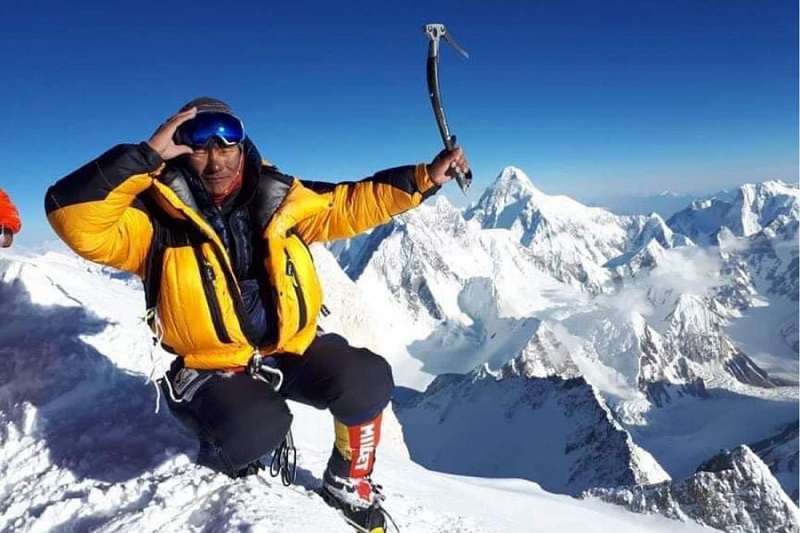Nepal: History on high mountains: Sanu Sherpa climbs world’s 14 tallest peaks — twice

Sanu Sherpa summits the 8,035-meter Gasherbrum II in Pakistan on July 21.
11:46 JST, August 4, 2022
In 2005, a sheep herder in a remote village of Nepal’s eastern mountain region came to Kathmandu with many dreams.
Sanu Sherpa from the Makalu village of Sankhuwasabha District had dreamt of making a good life in Kathmandu.
At the same time, he also had a goal of becoming a climbing guide, a high-paid and respected job that many of his peers would have thought of pursuing.
He initially worked as a porter.
In 2006, Sanu became a mountaineer after successfully climbing Cho Oyu (8,012 meters) on his first attempt.
After 17 years, Sanu has scripted history in the mountaineering fraternity.
The 47-year-old Sherpa became the first climber in the world to summit the planet’s 14 highest mountains, not once, but twice — a feat that no other climber has achieved.
He summited the 8,035-meter Gasherbrum II in Pakistan, the 13th highest mountain in the world, on the morning of July 21, his hiking agency Pioneer Adventure said.
“He was atop Gasherbrum II at 8:18 a.m. [Pakistan time], completing his double ascent of the world’s 14 highest peaks above 8,000 meters,” said Nivesh Karki, executive director of Pioneer Adventure.
The International Mountaineering and Climbing Federation recognizes eight-thousanders as the 14 mountains that are more than 8,000 meters in height above sea level. Among the 14, eight are in Nepal.
Social media was abuzz with congratulatory messages.
“MISSION DOUBLE 14x8000ERS [sic] achieved. Huge Congratulations,” Nang Norbu Sherpa, Sanu’s son, wrote on his Facebook page.
“Just got a call from the top of Gasherbrum II, this is a new WORLD RECORD [sic] in mountaineering history. Nobody has done such a feat. Super proud of you dad, we knew that you could do it with simplicity,” Nang Norbu wrote. “Witnessed your climbing ability in Mt. Kanchenjunga, you’re an outstanding 8000er climber without a doubt.”
Climbing all 14 peaks above 8,000 meters twice, actually, did not enter the mind of Sanu until 2019. That year, he had just completed single climbs of the mountains.
In 2020, the COVID-19 pandemic struck the world leading to a dramatic loss of human lives worldwide, including Nepal. Nepal closed all of its Himalayan peaks, only allowing a Bahraini team to climb Lobuche peak (6,119 meters) and Manaslu (8,156 meters) in October 2020, because of fears of the coronavirus outbreak.
Hundreds of trekking and climbing guides lost their jobs.
The climbing activities resumed in 2021 despite the COVID-19 surge.
“My father started getting clients in 2021 and summited four peaks,” Nang Norbu told the Post. “He then started thinking, why not other peaks.”
He then executed the plan with perfection.
Sanu climbed five peaks—Kanchenjunga (8,586 meters), Makalu (8,463 meters), Lhotse (8,516 meters) in Nepal, and Nanga Parbat (8,125 meters) and Gasherbrum II (8,035 meters) in Pakistan — this year.
After completing the spring expedition in April-May period, Sanu flew to Pakistan on June 11, said Karki. He conquered Nanga Parbat on July 2.
Sanu’s journey from a far-flung remote village to Kathmandu has its own adventures. The sad fact of the mountains was that over the years Sherpas have died most while guiding foreigners up to the peaks.
But since Sherpas used to make handsome earnings by guiding foreign climbers to Nepal’s countless peaks, the mountain guide profession was highly glamorous.
“That attracted my father too. Good income, good clothes and good food; a climbing Sherpa in a remote village used to be a hero,” said Nang Norbu.
Now, the situation is different.
“Our village is no longer remote. There is the Arun 3 hydropower project being built and the project has developed roads everywhere,” he said. “There is a 4G network in the village.”
But for Nang Norbu, it is still undecided whether he will follow in his father’s footsteps.
“Mountains are dangerous to climb. There is a risk factor. A big risk is associated with mountains,” said Nang Norbu, who has so far summitted two peaks — Ama Dablam and Lobuche — and reached Camp VI of Everest. “Actually, my father wants me to study. He doesn’t encourage me to join his profession.”
After Sanu came to Kathmandu in 2005, he got a job as kitchen help with an expedition team to Island Peak.
He made his mountaineering debut within a year.
“My father says he was in demand from foreign mountaineers because of his extra strength,” said his son.
In the spring of 2006, Sanu and two other climbing Sherpas guided 19 Korean mountaineers to Cho Oyu (8,012 meters).
Sanu succeeded in his first attempt.
Then in October of the same year, he climbed Shishapangma (8,012 meters) in China. After that, the rest is history, as they say.
Sanu has climbed Everest, the world’s tallest peak, seven times.
“It’s indeed a great achievement,” said Mingma Sherpa, another record holder from Sanu’s village, who now owns Nepal’s biggest expedition company.
On May 20, 2011, at the age of 32, Mingma Sherpa, the managing director of Seven Summits, became the first person from Nepal and the first South Asian to scale all 14 of the world’s highest mountains.
“Sanu did it in just 17 years. It’s difficult to climb the world’s highest 14 peaks,” said Mingma Sherpa. “He did it twice. To sum it up, he has simply made us proud.”




